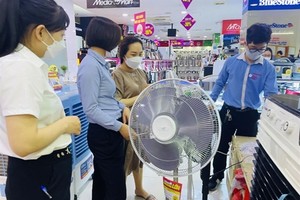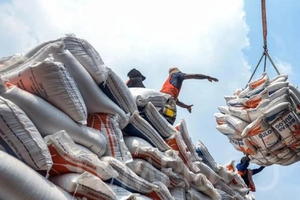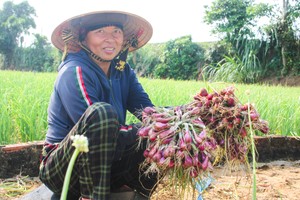 Loading and unloading of goods at ports is mainly done by hand, instead of machines. (Photo: SGGP)
Loading and unloading of goods at ports is mainly done by hand, instead of machines. (Photo: SGGP)
Removing difficulties for fishing ports
Song Doc Estuary is one of the largest and busiest estuaries in Ca Mau Province, where many fishing boats from inside and outside the province gather to anchor. The largest fishing port of the province – Song Doc – is located here. This port is capable of receiving about 45,000 tons of seafood per year. It has the main wharf of 100 meters in length and a bridge of over 50 meters and is capable of receiving 600CV vessels.
According to the Management Board of Ca Mau Fishing Ports, Song Doc Fishing Port has been upgraded but failed to keep up with demand because lots of fishing vessels with a length of above 15 meters concentrates in this estuary, leading to a huge demand for loading and unloading seafood. Sometimes it is impossible to clear all the goods in a short time, causing product quality to reduce and the rate of loss to increase.
Meanwhile, Ganh Hao Fishing Port in Dong Hai District in Bac Lieu Province is now degraded and overloaded after many years of use. Therefore, Bac Lieu Province has upgraded and expanded it with a capital of VND180 billion, of which, the central budget provides VND120 billion. The construction is carried out from 2017 to 2021, with the goal to upgrade Ganh Hao Fishing Port to meet the Class-I fishing port standards. However, the construction of this fishing port is forecasted to be unable to complete as planned, due to many arising problems that have not been resolved completely, including design adjustment and delayed site clearance. According to the Management Board of the investment and construction of agricultural and rural development projects in Bac Lieu Province, which is also the management unit of Ganh Hao Fishing Port, if the project is not completed by the end of this year, the Government may withdraw the support capital.
Recently, after the field trip to remove difficulties for Ganh Hao Fishing Port, Mr. Pham Van Thieu, Chairman of the People's Committee of Bac Lieu Province, asked functional departments to advise on the adjustment of the design of the fishing port, consider the source of capital allocated for the project to implement quickly, especially the arrangement of capital for site clearance. Mr. Thieu also directed that when the project of upgrading and expanding Ganh Hao Fishing Port is completed, it must serve the operation of vessels well because this is a project that contributes to helping Bac Lieu Province to enrich and thrive from the sea.
Urgent expansion of seafood processing establishments
The water of Ca Mau is one of the four key fishing grounds of the country. Currently, there are five fishing ports in the area. Of which, three fishing ports are of Class-II, namely Ca Mau, Song Doc, and Rach Goc fishing ports, and two fishing ports of Class-III, namely Cai Doi Vam and Ho Gu fishing ports. In the Mekong Delta, many fishing ports have been built or upgraded and expanded, but have not been as effective as expected yet.
According to the departments of Agriculture and Rural Development of Mekong Delta provinces, over the past time, the management, exploitation, and operation of fishing ports have always been paid attention to. Thanks to that, fishing vessels in and out of fishing ports for loading and unloading seafood, the control of output, and other issues at wharves have more changes than before. Besides, the coordination between fishing ports and functional sectors is also better, helping to monitor the loading and unloading output quite closely. However, the departments of Agriculture and Rural Development of Mekong Delta provinces also acknowledged that the proportion of products exploited through ports remained fairly low. Due to the custom, fishermen mainly sell seafood at spontaneous terminals or barns of enterprises, making it difficult to control fishing vessels in and out the ports. Moreover, there is a shortage of human resources for the management and operation of fishing ports and storm shelter anchorage areas, and the quality of staff is not high, mainly based on practical experience. The capacity of loading and unloading goods at fishing ports is also limited with a small number of stevedores and the job being carried out by hand instead of machines.
Amid these shortcomings, Mr. Nguyen Quang Khai, Director of the Management Board of Ca Mau Fishing Ports, said that to promote more effectively fishing ports, the unit has asked the authorities to adjust the planning at the fishing ports in the direction of expanding seafood processing establishments, increasing the added-value of seafood products, investing synchronously in infrastructure, especially connecting roads to fishing ports for vehicles with a load of over 10 tons to circulate conveniently. Mr. Khai also proposed to continue investing in the construction and upgrading of fishing ports. In which, there are some fishing ports qualified to become Class-I fishing ports. At the same time, they should implement well the provisions of the 2017 Law on Fisheries, accompany the whole country in removing the yellow card of the European Commission over illegal, unreported, and unregulated (IUU) fishing.
Song Doc Estuary is one of the largest and busiest estuaries in Ca Mau Province, where many fishing boats from inside and outside the province gather to anchor. The largest fishing port of the province – Song Doc – is located here. This port is capable of receiving about 45,000 tons of seafood per year. It has the main wharf of 100 meters in length and a bridge of over 50 meters and is capable of receiving 600CV vessels.
According to the Management Board of Ca Mau Fishing Ports, Song Doc Fishing Port has been upgraded but failed to keep up with demand because lots of fishing vessels with a length of above 15 meters concentrates in this estuary, leading to a huge demand for loading and unloading seafood. Sometimes it is impossible to clear all the goods in a short time, causing product quality to reduce and the rate of loss to increase.
Meanwhile, Ganh Hao Fishing Port in Dong Hai District in Bac Lieu Province is now degraded and overloaded after many years of use. Therefore, Bac Lieu Province has upgraded and expanded it with a capital of VND180 billion, of which, the central budget provides VND120 billion. The construction is carried out from 2017 to 2021, with the goal to upgrade Ganh Hao Fishing Port to meet the Class-I fishing port standards. However, the construction of this fishing port is forecasted to be unable to complete as planned, due to many arising problems that have not been resolved completely, including design adjustment and delayed site clearance. According to the Management Board of the investment and construction of agricultural and rural development projects in Bac Lieu Province, which is also the management unit of Ganh Hao Fishing Port, if the project is not completed by the end of this year, the Government may withdraw the support capital.
Recently, after the field trip to remove difficulties for Ganh Hao Fishing Port, Mr. Pham Van Thieu, Chairman of the People's Committee of Bac Lieu Province, asked functional departments to advise on the adjustment of the design of the fishing port, consider the source of capital allocated for the project to implement quickly, especially the arrangement of capital for site clearance. Mr. Thieu also directed that when the project of upgrading and expanding Ganh Hao Fishing Port is completed, it must serve the operation of vessels well because this is a project that contributes to helping Bac Lieu Province to enrich and thrive from the sea.
Urgent expansion of seafood processing establishments
The water of Ca Mau is one of the four key fishing grounds of the country. Currently, there are five fishing ports in the area. Of which, three fishing ports are of Class-II, namely Ca Mau, Song Doc, and Rach Goc fishing ports, and two fishing ports of Class-III, namely Cai Doi Vam and Ho Gu fishing ports. In the Mekong Delta, many fishing ports have been built or upgraded and expanded, but have not been as effective as expected yet.
According to the departments of Agriculture and Rural Development of Mekong Delta provinces, over the past time, the management, exploitation, and operation of fishing ports have always been paid attention to. Thanks to that, fishing vessels in and out of fishing ports for loading and unloading seafood, the control of output, and other issues at wharves have more changes than before. Besides, the coordination between fishing ports and functional sectors is also better, helping to monitor the loading and unloading output quite closely. However, the departments of Agriculture and Rural Development of Mekong Delta provinces also acknowledged that the proportion of products exploited through ports remained fairly low. Due to the custom, fishermen mainly sell seafood at spontaneous terminals or barns of enterprises, making it difficult to control fishing vessels in and out the ports. Moreover, there is a shortage of human resources for the management and operation of fishing ports and storm shelter anchorage areas, and the quality of staff is not high, mainly based on practical experience. The capacity of loading and unloading goods at fishing ports is also limited with a small number of stevedores and the job being carried out by hand instead of machines.
Amid these shortcomings, Mr. Nguyen Quang Khai, Director of the Management Board of Ca Mau Fishing Ports, said that to promote more effectively fishing ports, the unit has asked the authorities to adjust the planning at the fishing ports in the direction of expanding seafood processing establishments, increasing the added-value of seafood products, investing synchronously in infrastructure, especially connecting roads to fishing ports for vehicles with a load of over 10 tons to circulate conveniently. Mr. Khai also proposed to continue investing in the construction and upgrading of fishing ports. In which, there are some fishing ports qualified to become Class-I fishing ports. At the same time, they should implement well the provisions of the 2017 Law on Fisheries, accompany the whole country in removing the yellow card of the European Commission over illegal, unreported, and unregulated (IUU) fishing.
























